Nepenthes tobaica
Nepenthes tobaica /nɪˈpɛnθiːz toʊˈbaɪkə/ is a tropical pitcher plant endemic to Sumatra. It is particularly abundant around Lake Toba, after which it is named.
| Nepenthes tobaica | |
|---|---|
 | |
| A lower pitcher of Nepenthes tobaica | |
| Scientific classification | |
| Kingdom: | Plantae |
| Clade: | Tracheophytes |
| Clade: | Angiosperms |
| Clade: | Eudicots |
| Order: | Caryophyllales |
| Family: | Nepenthaceae |
| Genus: | Nepenthes |
| Species: | N. tobaica |
| Binomial name | |
| Nepenthes tobaica | |
| Synonyms | |
| |
Nepenthes tobaica is closely related to N. angasanensis, N. gracilis, N. mikei, and N. reinwardtiana.[5]
Botanical history
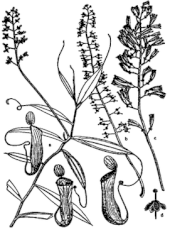
The earliest known collection of N. tobaica was made by Johannes Elias Teijsmann on February 8, 1856, probably from the Batak regions. This specimen, which includes female floral material, is H. L. B. 908,155-1106.[2]
Matthew Jebb and Martin Cheek designated this specimen as the lectotype of N. tobaica in their 1997 monograph.[6]
Nepenthes tobaica was formally described[note a] in 1928 by Dutch botanist B. H. Danser in his seminal monograph "The Nepenthaceae of the Netherlands Indies".[2] At the time, the species was already known from numerous herbarium specimens.[note b] Danser suggested a possibly conspecific species in N. reinwardtiana:[2]
"N. tobaica has only been found on the plateau north, east and south of Lake Toba. It is most closely related to N. Reinwardtiana and I am not quite certain, whether it is perhaps a form of this species, but up till now no intermediate forms have been discovered."
In the scientific literature, N. tobaica has been confused with the closely related N. angasanensis on several occasions. Nepenthes tobaica as described in Danser's 1940 description of N. densiflora[3] is actually N. angasanensis.[5] Specimens identified as N. tobaica in Rusjdi Tamin and Mitsuru Hotta's 1986 monograph[4] on Sumatran Nepenthes actually represent both N. angasanensis and N. tobaica.[5]
Some plants sold in the horticultural trade under the name N. tobaica are likely to represent a manmade cross between N. khasiana and N. ventricosa.[7]
Description
Nepenthes tobaica is a climbing plant. The stem can attain a height of up to 7 m and is up to 6 mm in diameter. Internodes are up to 25 cm long and often round in cross section. However, mature plants may have angular stems because of a groove that originates at the node and extends across most of the internode's length.[5]
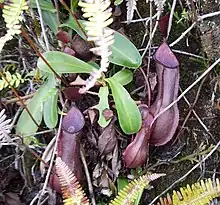
Leaves are coriaceous in texture and range from sessile to sub-petiolate. The shape of the lamina, or leaf blade, varies from oblong to spathulate. It measures up to 20 cm in length by 4 cm in width. The apical end of the lamina is typically rounded, but may be narrowed and obtuse. Robust plants sometimes have a sub-peltate tendril insertion. The lamina may be gradually or abruptly contracted towards the amplexicaul base, which clasps the stem for around half of its circumference. One to three longitudinal veins are present on either side of the midrib, although they are only prominent in robust specimens. Pinnate veins are indistinct. Tendrils grow to 30 cm in length.[5]
Rosette and lower pitchers are ovoid in the lower portion and cylindrical above. They are up to 20 cm high by 4 cm wide. A pair of wings runs down the pitcher's ventral surface, often bearing fringe elements either throughout the whole length or only in the upper part. The glandular region of the pitcher's inner surface is confined to the ovoid portion. A pair of "eye spots" is sometimes present on the inner surface, below the lid attachment. The pitcher mouth is ovate and has an oblique insertion. The narrow peristome (≤5 mm wide) is cylindrical or slightly expanded and bears indistinct teeth. The pitcher lid or operculum is ovate to sub-orbicular and has a somewhat cordate base. It lacks appendages. A spur measuring up to 5 mm in length is inserted near the base of the lid. It may be unbranched, bifid, or trifid.[5]
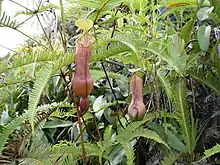
Upper pitchers are typically somewhat infundibular in the lowermost part, becoming narrowly ovoid in the lower third, and finally cylindrical and slightly narrower above. They may be quite large, reaching 25 cm in height by 5 cm in width.[5] The waxy zone of the inner surface is well developed.[8] A pair of remnant ribs is present in place of the ventral wings.[5] The inner portion of the peristome accounts for around 40% of its total cross-sectional surface length.[8] Other parts of aerial pitchers are similar to their lower counterparts.[5]
Nepenthes tobaica has a racemose inflorescence. The peduncle and rachis can each grow to 20 cm in length. Partial peduncles are two-flowered and lack bracteoles. In male inflorescences, the sepals are elliptic-obtuse, being slightly narrower in female ones.[5] Around the town of Prapat, plants have been observed to come into flower in April, although mature fruits are not common at this time.[9]
Nepenthes tobaica is characterised by an uneven indumentum. Most mature vegetative parts are glabrous, although the midrib may bear persistent hairs. Groups of white, stellate hairs are often present in the leaf axils. The sepals of this species are densely tomentose, but the rest of the inflorescence has a sparser covering of short hairs.[5]
In some forms, the underside of the lid is a vivid red, making the plants particularly easy to spot amongst other vegetation.[9]
Ecology

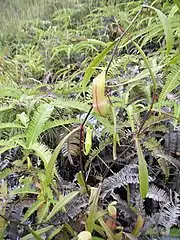
Nepenthes tobaica is endemic to Sumatra. Its natural range was once thought to stretch from the Gayo Lands of Aceh in the north to Tarutung in the south. Towards the end of the 20th century, new locations of this species were discovered further south. These include Mount Sorik Merapi and a unique high altitude peat swamp habitat near Lake Kerinci in Jambi.[5] Charles Clarke cites its altitudinal range as 380 to 1800 m above sea level, with a habitat near the port town of Sibolga constituting the lower extreme and Mount Pangulubao the upper extreme. However, according to Matthew Jebb and Martin Cheek, N. tobaica can grow at altitudes of up to 2750 m.[1][6]
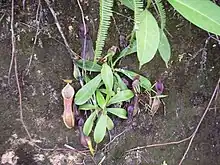
This species typically grows terrestrially in exposed areas.[5] Nepenthes tobaica commonly grows in forest edges, where it is often sympatric with species of Leptospermum and Rhodomyrtus.[1]
Nepenthes tobaica is very abundant in the Lake Toba region,[10] to the point where it is "difficult to avoid seeing it there".[5] N. tobaica is also known to grow in high altitude peat swamp forest near Lake Kerinci, at an altitude of 1100 m. At this location, the species grows alongside N. ampullaria, N. gracilis, N. mirabilis, N. reinwardtiana, and N. spathulata. The Nepenthes species and hybrids at this site exhibit high levels of introgression. The vegetation is dominated by species of the genera Rhododendron and Melastoma, as well as orchids and ferns. It is very stunted and dense, with few trees exceeding 3 m in height. It is somewhat reminiscent of the highland heath forests around Bareo in Sarawak, Borneo.[5]
The conservation status of N. tobaica is listed as Least Concern on the IUCN Red List based on an assessment carried out in 2018.[1]
Related species

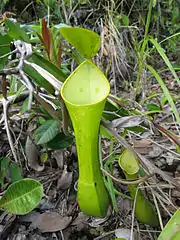
| Character | N. angasanensis | N. mikei | N. tobaica |
|---|---|---|---|
| Habit | Produces offshoots from underground rhizomes | No rhizomes | No rhizomes |
| Spur | Forked | Fasciculate | Filiform |
| Inner margin of peristome | Teeth to 1.5–2 mm long | Teeth to 0.2-0.4 mm long | Teeth < 0.2 mm |
| Stem cross section | Cylindrical | Cylindrical | Cylindrical to obtusely triangular |
| Bracteoles | Sometimes near base of lowest pedicel only | Half way up every pedicel | At base or slightly below pedicel attachment, few |
| Pitcher glands | 300 / cm² | 150-180 / cm² | 200-250 / cm² |
| Pedicels | 1-flowered | 1-flowered | 2-flowered |
| Inflorescence (female) | 55–125 mm long, 9-17 flowers | 40–80 mm long, 4-10 flowers | 195–400 mm long, 30-50 flowers |
In 2001, Charles Clarke performed a cladistic analysis of the Nepenthes species of Sumatra and Peninsular Malaysia using 70 morphological characteristics of each taxon. The following is a portion of the resultant cladogram, showing part of "Clade 6". The sister pair of N. angasanensis and N. mikei has 79% support.[5]
| ||||||||||||||||||||||||||||
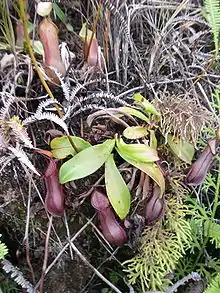
The pitchers of N. tobaica are similar to those of N. adnata, although the stem and lamina are quite different.[5]
Natural hybrids
Five natural hybrids involving N. tobaica have been recorded to date; specifically, crosses with N. ampullaria, N. reinwardtiana, N. rhombicaulis, N. spathulata, and N. spectabilis.[5][13][14]
Notes
Folia mediocria sessilia, lamina lineari-lanceolata, nervis longitudinalibus utrinque 0-1, raro 2, basi lata semiamplexicauli ; ascidia rosularum ignota ; ascidia inferiora parte inferiore anguste ovata, medio angustata, os versus infundibuliformia, alis 2 fimbriatis, peristomio operculum versus acuto, cylindrico, 1/2-1 mm lato, costis 1/3-1/4 mm distantibus, saepe indistinctis, dentibus fere 0 ; operculo rotundato-elliptico, facie inferiore plano ; ascidia superiora parva, e basi infundibuliformi parte inferiore paulum ventricosa, medio leviter angustata, os versus paulum infundibuliformia, costis 2 prominentibus, peristomio operculum versus acuto, cylindrico, 1/2-1 mm lato, costis 1/3-1/4 mm distantibus, saepe indistinctis, dentibus fere 0 ; operculo orbiculari v. rotundato-elliptico facie interiore plana ; inflorescentia racemus pedicellis 13-15 mm longis fere omnibus 2-floris ; indumentum in inflorescentiis et ascidiis parcum stellatum, ceterum 0.
- b.^ In addition to the earliest specimen, collected by Teijsmann in 1856, Danser lists 11 separate collections of N. tobaica.
References
- Clarke, C.M. (2018). "Nepenthes tobaica". IUCN Red List of Threatened Species. 2018: e.T39705A143965440. doi:10.2305/IUCN.UK.2018-1.RLTS.T39705A143965440.en. Retrieved 19 November 2021.
- Danser, B.H. 1928. 45. Nepenthes tobaica DANS., spec. nova.. In: The Nepenthaceae of the Netherlands Indies. Bulletin du Jardin Botanique de Buitenzorg, Série III, 9(3–4): 249–438.
- Danser, B.H. 1940. A new Nepenthes from Sumatra. Bulletin du Jardin Botanique de Buitenzorg, Série III, 16: 268–271.
- (in Indonesian) Tamin, R. & M. Hotta 1986. Nepenthes di Sumatera: The genus Nepenthes of the Sumatra Island. In: M. Hotta (ed.) Diversity and Dynamics of Plant Life in Sumatra: Forest Ecosystem and Speciation in Wet Tropical Environments. Part 1: Reports and Collection of Papers. Kyoto University, Kyoto. pp. 75–109.
- Clarke, C.M. 2001. Nepenthes of Sumatra and Peninsular Malaysia. Natural History Publications (Borneo), Kota Kinabalu.
- Jebb, M.H.P. & M.R. Cheek 1997. A skeletal revision of Nepenthes (Nepenthaceae). Blumea 42(1): 1–106.
- Catalano, M. 2009. Nepenthes. In: Growing Carnivores — an Italian perspective. Prague. pp. 50–57.
- Bauer, U., C.J. Clemente, T. Renner & W. Federle 2012. Form follows function: morphological diversification and alternative trapping strategies in carnivorous Nepenthes pitcher plants. Journal of Evolutionary Biology 25(1): 90–102. doi:10.1111/j.1420-9101.2011.02406.x
- Shivas, R.G. 1984. "The Lake Toba Nepenthes" (PDF). Carnivorous Plant Newsletter 13(1): 15–16.
- Russell, G. 1985. "Sumatran Expedition January 1985" (PDF). Carnivorous Plant Newsletter 14(4): 97–101.
- Oudemans, A.C. 1932. Opus 550. Tijdschrift voor Entomologie 75: 202–210.
- Fashing, N.J. 2002. "Nepenthacarus, a new genus of Histiostomatidae (Acari: Astigmata) inhabiting the pitchers of Nepenthes mirabilis (Lour.) Druce in Far North Queensland, Australia" (PDF). (1.64 MiB) Australian Journal of Entomology 41(1): 7–17. doi:10.1046/j.1440-6055.2002.00263.x
- McPherson, S.R. 2009. Pitcher Plants of the Old World. 2 volumes. Redfern Natural History Productions, Poole.
- (in Indonesian) Dariana 2010. Keanekaragaman Nepenthes dan pohon inang di Taman Wisata Alam Sicikeh-Cikeh Kabupaten Dairi Sumatera Utara. M.Sc. thesis, University of North Sumatra, Medan.
Further reading
- (in Indonesian) Akhriadi, P. 2007. Kajian taksonomi hibrid alami Nepenthes (Nepenthaceae) di Kerinci. Working paper, Andalas University, Padang. Abstract
- Bonhomme, V., H. Pelloux-Prayer, E. Jousselin, Y. Forterre, J.-J. Labat & L. Gaume 2011. Slippery or sticky? Functional diversity in the trapping strategy of Nepenthes carnivorous plants. New Phytologist 191(2): 545–554. doi:10.1111/j.1469-8137.2011.03696.x
- Hernawati & P. Akhriadi 2006. A Field Guide to the Nepenthes of Sumatra. PILI-NGO Movement, Bogor.
- Hopkins, M., R. Maulder & B.[R.] Salmon 1990. "A real nice trip to Southeast Asia" (PDF). (1.72 MiB) Carnivorous Plant Newsletter 19(1–2): 19–28.
- Kitching, R.L. 2000. Food Webs and Container Habitats: The natural history and ecology of phytotelmata. Cambridge University Press, Cambridge.
- (in Indonesian) Mansur, M. 2001. "Koleksi Nepenthes di Herbarium Bogoriense: prospeknya sebagai tanaman hias" (PDF). Archived from the original (PDF) on 2012-03-19. In: Prosiding Seminar Hari Cinta Puspa dan Satwa Nasional. Lembaga Ilmu Pengetahuan Indonesia, Bogor. pp. 244–253.
- McPherson, S.R. & A. Robinson 2012. Field Guide to the Pitcher Plants of Sumatra and Java. Redfern Natural History Productions, Poole.
- Meimberg, H., P. Dittrich, G. Bringmann, J. Schlauer & G. Heubl 2000. Molecular phylogeny of Caryophyllidae s.l. based on matK sequences with special emphasis on carnivorous taxa. Plant Biology 2(2): 218–228. doi:10.1055/s-2000-9460
- Meimberg, H., A. Wistuba, P. Dittrich & G. Heubl 2001. Molecular phylogeny of Nepenthaceae based on cladistic analysis of plastid trnK intron sequence data. Plant Biology 3(2): 164–175. doi:10.1055/s-2001-12897
- (in German) Meimberg, H. 2002. "Molekular-systematische Untersuchungen an den Familien Nepenthaceae und Ancistrocladaceae sowie verwandter Taxa aus der Unterklasse Caryophyllidae s. l." (PDF). Ph.D. thesis, Ludwig Maximilian University of Munich, Munich.
- Meimberg, H. & G. Heubl 2006. Introduction of a nuclear marker for phylogenetic analysis of Nepenthaceae. Plant Biology 8(6): 831–840. doi:10.1055/s-2006-924676
- Meimberg, H., S. Thalhammer, A. Brachmann & G. Heubl 2006. Comparative analysis of a translocated copy of the trnK intron in carnivorous family Nepenthaceae. Molecular Phylogenetics and Evolution 39(2): 478–490. doi:10.1016/j.ympev.2005.11.023
- Renner, T. & C.D. Specht 2011. A sticky situation: assessing adaptations for plant carnivory in the Caryophyllales by means of stochastic character mapping. International Journal of Plant Sciences 172(7): 889–901. doi:10.1086/660882
- Salmon, B. & R. Maulder 1999. Notes on Nepenthes from Northern Sumatra. Carnivorous Plant Newsletter 28(1): 14-18.
- Thornhill, A.H., I.S. Harper & N.D. Hallam 2008. The development of the digestive glands and enzymes in the pitchers of three Nepenthes species: N. alata, N. tobaica, and N. ventricosa (Nepenthaceae). International Journal of Plant Sciences 169(5): 615–624. doi:10.1086/533599
